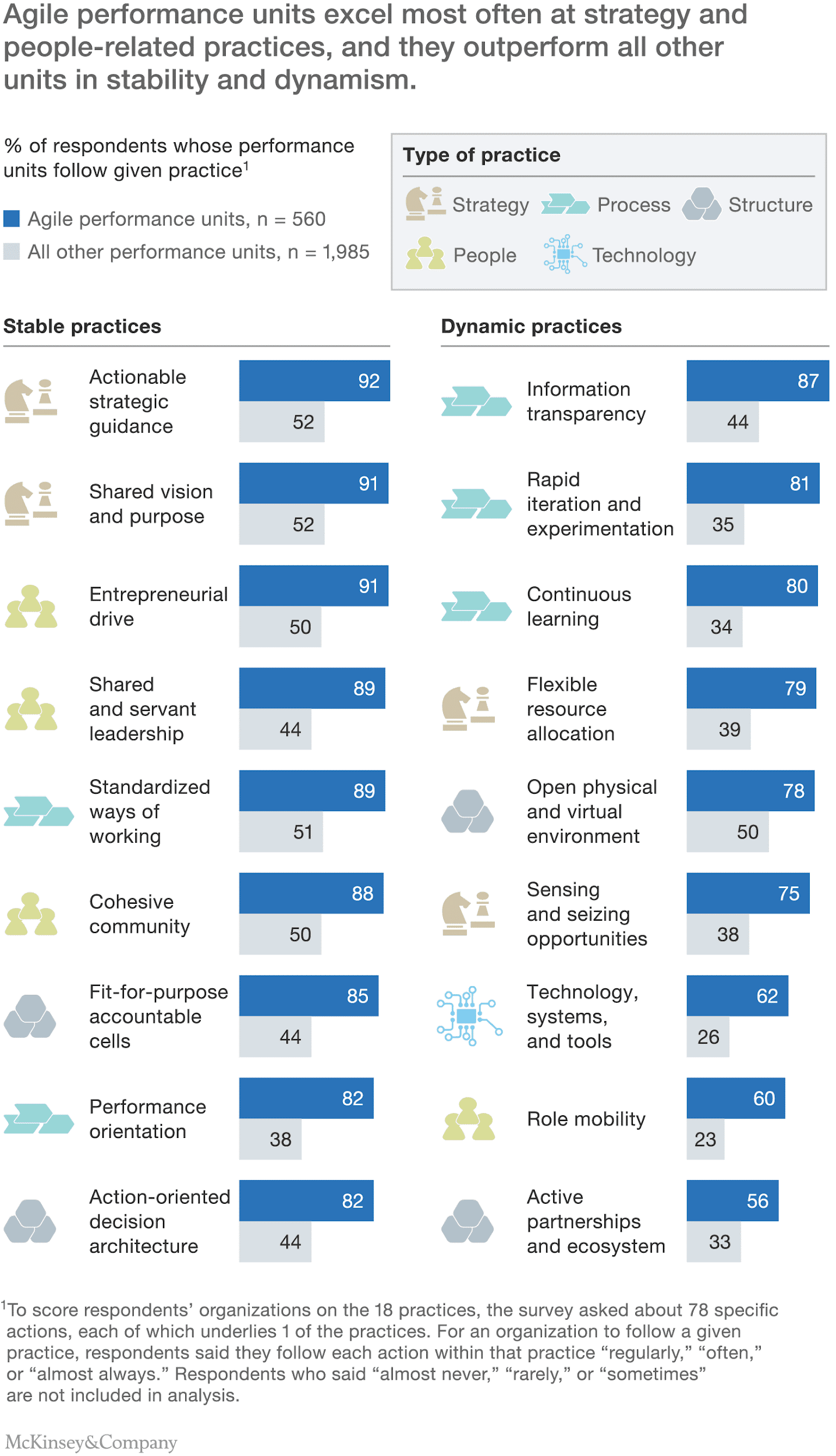
Researchers at McKinsey&Company have found that in order to achieve organizational agility (in order to be agile)—which the firm defines as “…the ability to quickly reconfigure strategy, structure, processes, people, and technology toward value-creating and value-protecting opportunities”—organizations need to have an appropriate balance of dynamism and stability.
Dynamic practices are those we often think of when we discuss organizational agility. They enable teams to respond quickly and nimbly to new threats and opportunities. They help keep organizations, even large, complex enterprises, on their figurative toes, so they do not crumble when facing new obstacles.
Stable practices cultivate efficiency and sustainability by, as McKinsey writes, “…establishing a backbone of elements that don’t need to change frequently.” Just as good habits in your personal life—making your bed, getting enough sleep, getting your oil changed in your car—enable you to devote more energy to growth and progress, stable practices enable organizations with the efficiency, reliability, and structure needed to scale.
Balancing Dynamism and Stability
Balancing these two forces—dynamism and stability—is the key to organizational agility. And it’s not easy. In a recent McKinsey Global Survey, researchers asked respondents about a series of specific actions that underlie each of the 18 practices determined to promote organizational agility. To rate respondents’ organizations, they asked how frequently their performance units engaged in each action that supports a given practice.
Of the ‘Agile’ organizations surveyed, only 22% were found to be truly Agile, meaning they have achieved a balance of dynamism and stability. The other organizations surveyed lacked either dynamism, stability, or both:
- Organizations who favor dynamic practices (28%) followed a mode of operating that is suited to small start-ups but lacked the stability practices necessary to scale.
- Organizations favoring stability practices (27%) remain rooted in bureaucracy, making it difficult to respond to opportunities and threats.
- Organizations lacking in both stability and dynamism (23%)—which McKinsey classifies as “Trapped”—are least equipped to withstand disruption.
18 Practices for Organizational Agility
Agile organizations outperform traditional organizations in each of the 18 practices shown to promote organizational agility, as seen in the figure below. Here are brief definitions of each of the eighteen practices (9 dynamic and 9 stable) to help you assess your own organization’s agility.

Stable Practices
Shared Vision and Purpose
A shared vision and purpose is critical to promoting stability in a Lean-Agile enterprise. Awareness of, and confidence in, a shared vision helps people feel personally and emotionally invested in their work, which can inspire innovation and bolster continuous improvement efforts.
Defining and aligning around a shared vision and purpose at the organizational level is a collective effort, that requires the involvement of a group often overlooked: Those actually doing the work.
Actionable Strategic Guidance
Aligning around a shared vision and purpose is an important step toward creating stability in the workplace. The next, and arguably more difficult step, is to actually align the daily efforts of teams towards strategic goals.
In successful Lean-Agile organizations, employees understand how their work aligns with both the high-level, cultural values of the organization, as well as the specific objectives that advance the organization’s strategy. Put more simply, they understand the why behind their work.
Leaders and peers reinforce this alignment by providing frequent feedback and coaching. This allows teams and the individuals within them to work autonomously, while staying aligned with larger strategic objectives.
Entrepreneurial Drive
While you might think of entrepreneurial drive as a more dynamic practice, at the organizational level, it actually promotes stability. When entrepreneurial drive is an innate part of organizational culture, employees proactively identify and pursue opportunities to create new ideas, initiatives, and trends. This helps protect the organization against the threat of disruption, while also making it more attractive to talented candidates.
Shared and Servant Leadership
Servant leadership is not only good for morale, it’s also good for the sustainability of the organization. In Lean-Agile organizations, leaders inspire people to act in team-oriented, customer-focused ways, helping to reinforce a culture that is shown to be more profitable in the modern world. This leadership style is also critical in ensuring teams feel supported and have the proper guidance, mentoring, and coaching to work autonomously.
Standardized Ways of Working
Standardized ways of working promote stability by making collaboration seamless and accessible across value streams. Practices like standardized meeting formats enable quick execution of day-to-day activities.
Cohesive Community
In Agile organizations, people trust each other to act in the best interests of the organization, its customers, and other key stakeholders. This sense of community is reinforced through fit-based hiring practices and positive peer pressure (instead of rules or hierarchy).
Fit-for-Purpose Accountable Cells
Organizing around value streams—as opposed to projects—is one of the hallmarks of Lean-Agile practices. Teams are small, self-organizing, and accountable for the end-to-end work of a specific process or service.
Performance Orientation
Traditionally, organizations aspire to achieve team goals while incentivizing individual performance. Agile organizations align individuals around shared, metrics-based team goals. Individuals, teams, and units are evaluated by cross-functional business metrics and targets, which encourage stability by promoting transparency, teamwork, and better capacity planning.
Action-Oriented Decision Architecture
An action-oriented decision architecture promotes stability by encouraging action of the whole over input of specific individuals. This prevents the long delays often found in bureaucracies, where decision-making power is concentrated at the top. In Agile organizations, decision-making processes and norms are clear and widely followed. The people closest to the work are empowered to make decisions that affect the implementation of their day-to-day activities. This promotes stability by empowering employees and enabling speed.
Dynamic Practices
Sensing and Seizing Opportunities
In Agile organizations, everyone is on the lookout for opportunities and threats. Individuals are empowered to watch for and act upon changes in customer preferences and the external environment—not just the people at the top.
Flexible Resource Allocation
Agility is all about being able to learn and adapt quickly. Having a clear, efficient process for deploying and redeploying people between initiatives as priorities shift is a critical dynamic practice.
Active Partnerships and Ecosystem
No man is an island, and no organization is either. Just as collaboration within an organization breeds innovation, so does collaboration outside of the organization. In Agile organizations, employees work hands-on with customers, vendors, and other partners to develop new products, services, and/or solutions and bring them to market.
Open Physical and Virtual Environment
Agile organizations aim to create work environments (both physical and virtual, for distributed teams) so that people can communicate and collaborate with each other, even if they do not work together day-to-day. They also create environments where all types of people can do their best work (for example, providing the right types of office space for those who need quiet for focused work, as well as those who need to take video calls or gather in small or large groups).
Rapid Iteration and Experimentation
Fail fast and learn quickly—that is one of the informal ‘mottos’ of Agile. Agile teams develop solutions through fast cycles of field testing and learning from mistakes. Products and solutions are developed iteratively using minimum viable products (MVPs)—the minimum set of features needed to test and learn.
Information Transparency
The accessibility, accuracy, and availability of quality, unfiltered data is critical for organizational agility at scale. People need the ability to easily share ideas from, and results of, their work with those who might benefit from the information.
Continuous Learning
Continuous learning happens on both the individual and organizational levels in Agile organizations. At the individual level, people actively dedicate time to look for ways to improve their way of working. At the organizational level, structured processes and tools enable the sharing of tribal knowledge—information learned across the organization through experimentation and experience.
Role Mobility
In traditional organizations, individuals are hired to fulfill specific roles, and ideally will move vertically to more senior versions of that role as they gain experience. This type of structure doesn’t allow for individuals to explore roles and teams based on their personal development goals; if they don’t enjoy their work or team and don’t see opportunities for advancement, they leave in search of a role better suited to them in a different organization. Agile organizations function as an open talent marketplace where available roles, tasks, and projects are clear and available, and individuals are encouraged to move both vertically and horizontally based on the knowledge, skills, and networks they want to build.
Technology, Systems, and Tools
Finally, in order to be Agile, you need the right technology, systems, and tools for the job. Architecture, infrastructure, practices, and tools are seamlessly integrated with key processes and responsive to changing business needs.
To learn more about how to create a Lean-Agile culture in your organization, read our “5 Lean-Agile Culture Shifts to Achieve and Sustain Organizational Agility” eBook.






